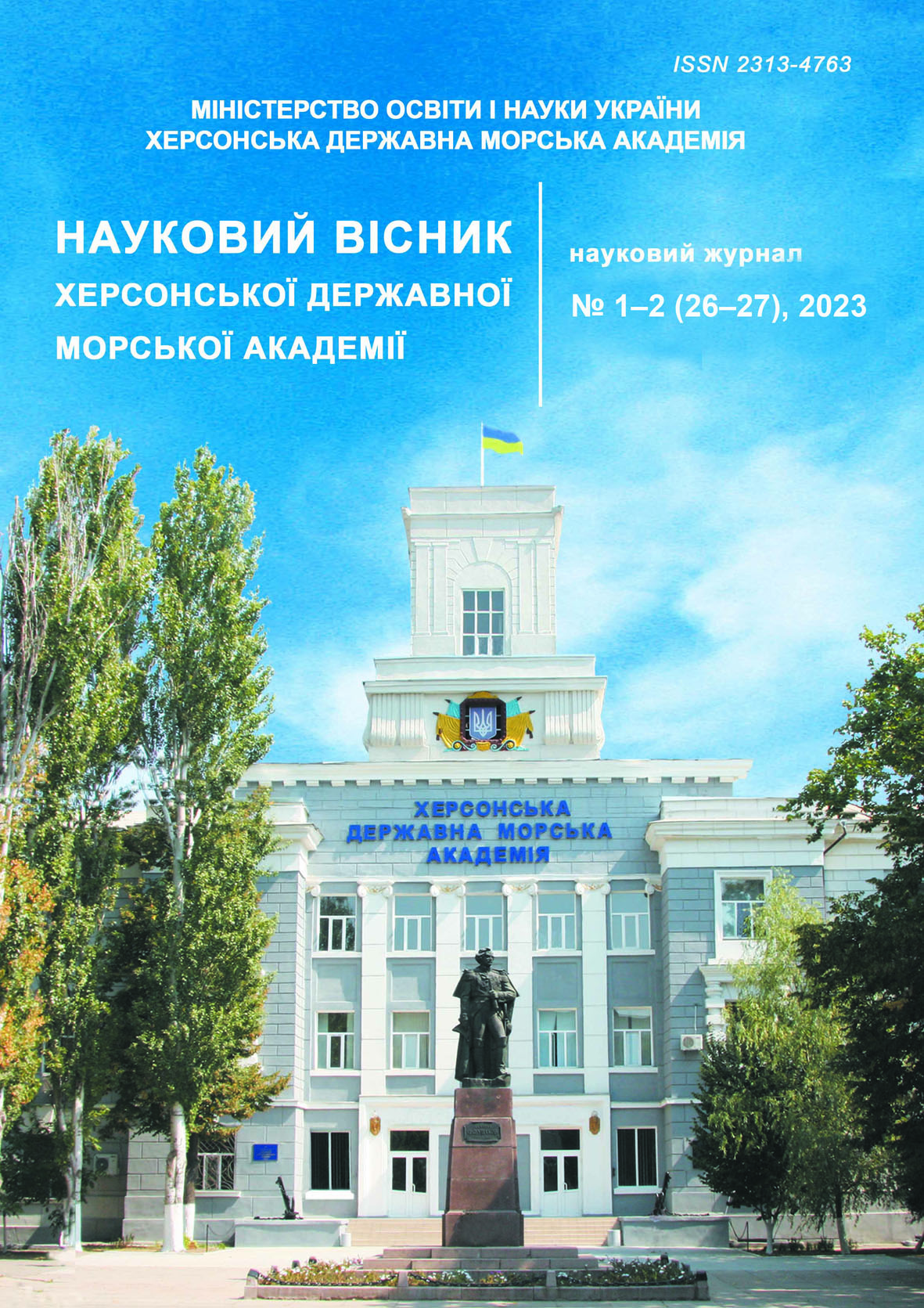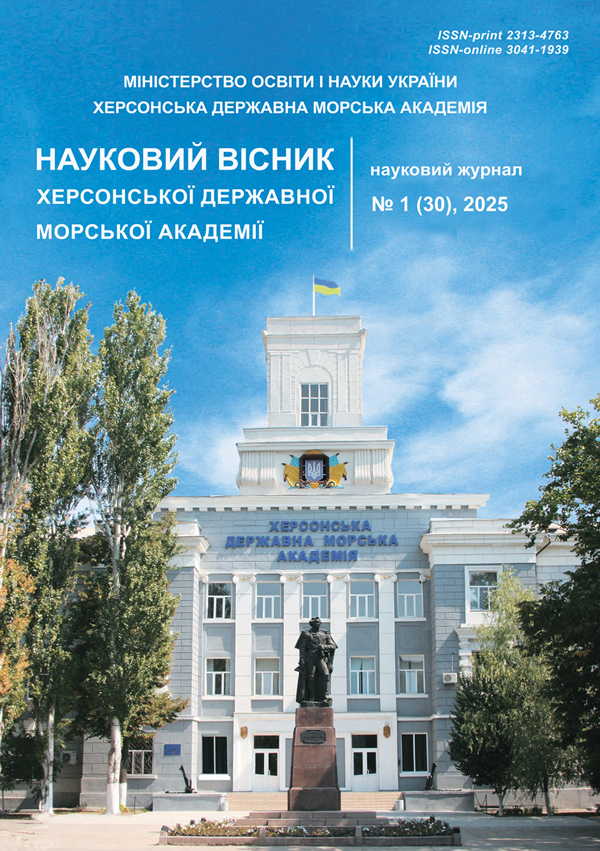MODELS FOR SIMULATING RADAR ECHO SIGNALS IN A VIRTUAL TRAINING SYSTEM
https://doi.org/10.33815/2313-4763.2025.1.30.092-101
Abstract
In the current context of educational process transformation, ensuring the effective acquisition of practical skills by cadets in maritime academies has become increasingly important. Restrictions related to physical attendance in classrooms, along with the high cost of commercial cloud-based simulators, significantly limit the possibilities for interactive training of navigators. Simulator systems based on hardware-software integration are often difficult to scale in line with modern educational demands. Against this background, the development of mathematical models enabling real-time radar echo simulation without dependence on physical hardware is a promising direction of research. This article presents mathematical models designed to graphically simulate radar echo reflections from moving and stationary surface objects. A method of dynamic angular shadow intervals is proposed. The construction of sinusoidal radar echoes along “visible” segments (2D facets) of a polyline (Land Danger contour) enables realistic visualization of radar signals while considering the geometry of surface targets. These sinusoidal profiles are then combined into a unified radar response within the polar radius. The article introduces a model of a unique visibility metric for 2D facets in a polar sector, calculated analytically rather than constructed via bit masking. The logic of dynamic “shadow accumulation”—expanding angular shadow intervals over time—represents a novel implementation of the “dynamic occlusion” concept in a polar observation space relative to a moving vessel. The provided echo signal simulation model corresponds to the real one without taking into account the physical shadow zones of the ship's radar, which are formed due to the arrangement of high deck structures on the vessel that obstruct the circular propagation of the radar signal.
References
2. Petrovskyi, A. V. (2025). Certificate of state registration of copyright for the computer program “SimulationBridgeMasterE” No. 135550.
3. Petrovskyi, A. V. (2025). Certificate of state registration of copyright for “Mathematical Models of Radar Echo Simulation” No. 136680.
4. Petrovskyi, A. V., Sokurenko, Ya. O., & Ziablov, D. O. (2025). Development of a radar simulation software module “Bridge Master E” for distance learning conditions. In Proceedings of the 17th International Scientific and Practical Conference “Modern Information and Innovative Technologies in Transport” (Odesa, Ukraine, May 28–30, 2025) (pp. 87–89).
5. Reichl, M., Dünger, R., Schiewe, A., Klemmer, T., Hartleb, M., Lux, C., & Fröhlich, B. (2010). GPU-based ray tracing of dynamic scenes. Journal of Virtual Reality and Broadcasting.
6. Petrovs'kyi, A. V., & Lytovchenko, V. I. (2025). Study of the structure of modern ENC charts in S57 format. In Proceedings of the 17th International Scientific and Practical Conference “Modern Information and Innovative Technologies in Transport” (Odesa, Ukraine, May 28–30, 2025) (pp. 90–93).
7. Havel, J., & Herout, A. (2010). Yet faster ray–triangle intersection (using SSE4). IEEE Transactions on Visualization and Computer Graphics, 16(3), 434–438. https://doi.org/10.1109/TVCG.2009.85.
8. Sobota, B., Korečko, Š., Szabó, C., & Hrozek, F. (2014). Acceleration of ray tracing method using predictive evaluation and GPGPU technology. Central European Journal of Computer Science, 4(2), 118–126. https://doi.org/10.2478/s13537-014-0203-2.
9. Li, J., Wang, X., & Zhang, Y. (2016). A fast ray tracing algorithm based on a hybrid structure. Multimedia Tools and Applications, 75(5), 1883–1898. https://doi.org/10.1007/s11042-014-2380-9.
10. Kautz, J., Widmer, S., Pajak, D., & Schulz, A. (2015). An adaptive acceleration structure for screen-space ray tracing. Proceedings of High-Performance Graphics.
11. Vitek, O., & Mrazek, P. (2019). Iterative ray-traced collision detection algorithm for GPU architectures. Academia.edu.
12. Wald, I., Boulos, S., & Shirley, P. (2011). Ray tracing deformable scenes using dynamic bounding volume hierarchies. ACM Transactions on Graphics, 26(1), 6. https://doi.org/10.1145/1186640.1186647.
13. Liu, X., et al. (2010). Real-time ray tracing with massively parallel bounding volume hierarchy construction. ACM Transactions on Graphics, 29(6), 1–10. https://doi.org/10.1145/1882261.1866206.
14. Cho, S., Park, J., Kim, J., & Lee, S. (2014). HART: A hybrid architecture for ray tracing animated scenes. Proceedings of the 2014 IEEE Symposium on Interactive Ray Tracing. https://doi.org/10.1109/RT.2014.6893655.
15. Willis, A. R., Hossain, M. S., & Godwin, J. (2020). Hardware-accelerated SAR simulation with NVIDIA RTX technology. arXiv preprint arXiv:2005.09736. https://doi.org/10.48550/arXiv.2005.09736.
16. Geng, H., & Wang, S. (2023). Shooting and bouncing rays (SBR) method for electromagnetic simulation. In Electromagnetic Scattering Handbook (pp. 121–142). Springer. https://doi.org/10.1007/978-3-030-47373-8_5.
17. Wei, J., Lu, Y., Zhang, X., & Xu, F. (2024). Learning surface scattering parameters from SAR images using differentiable ray tracing. arXiv preprint arXiv:2402.06547. https://doi.org/10.48550/arXiv.2402.06547.
18. Liang, D., Zhang, Z., & Huang, J. (2023). Ray-tracing-assisted SAR image simulation under range Doppler imaging geometry. Electronics, 12(3), 589. https://doi.org/10.3390/electronics12030589.
19. Chan, K. C., et al. (2013). GRay: A geometrically-based ray tracing engine. Computer Graphics Forum, 32(6), 123–134. https://doi.org/10.1111/cgf.12237.






